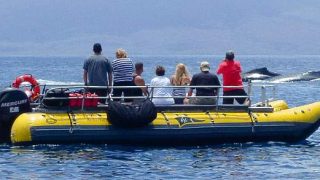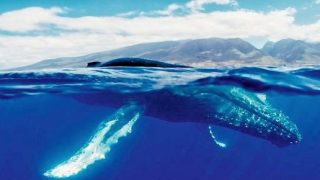National Geographic amazingly witnessed and filmed complete birth of a humpback whale off Lahaina Maui. This is something that has never been witnessed before.
A whale researcher, Rachel Cartwright, expressed the significance, saying, “We’ve been waiting for this for 25 years.” She’s with the Keiki Kohola Project, a Maui nonprofit dedicated to protecting humpback whale mothers and calves.
Despite monitoring Female humpback whales that are in labor may be seen as a result of calf flukes protruding. But witnessing the entire birth has been elusive.
Watch this tomorrow on National Geographic’s “Incredible Animal Journeys.”
The birth will be featured in National Geographic’s series premiering November 19, 2023. It will also be featured on Disney+ and on Hulu starting this Monday. The actual filming took place in 2021 but has never been seen before to our knowledge.
The birth began at about 3 p.m. as a research boat spotted a pod of male humpbacks found near a female, which suggested mating behavior. A crew member went into the ocean to film, and discovered a small fluke indicating the birth potential. The team used drones to help record this first complete humpback whale being delivered. The footage revealed a burst of blood followed by the appearance of a male calf.
As they were observing and celebrating the extraordinary birth, scientists observed unusual behavior. It was unexpected that a collection of male humpbacks were around the female. The males reportedly released bubbles, which may be related to courtship or hormones.
Join us in Hawaii for humpback whale season!
Hawaii’s humpback whale season kicked off last month with sightings off Maui and the Big Island, captivating locals and visitors alike. The annual data collection, dating back to the 1980s, begins this month to monitor the migration of these majestic creatures from Alaska to Hawaii, tracking their interactions with shifting prey patterns and climate change in addition to the recent Maui wildfires.
Up to 12,000 humpback whales cover a remarkable 3,000-mile journey each way from Alaska to Hawaii, providing ample opportunities for observation from now through spring, with peak season occurring from December to March.
NOAA’s Hawaiian Islands Humpback Whale National Marine Sanctuary, established a quarter-century ago, plays a crucial role in protecting humpback whales—the only place in the U.S. where these whales reproduce. Though the exact duration of humpbacks using Hawaiian waters for mating and reproduction is unknown, records trace back to 1840.
For those preferring land-based Hawaii whale watching.
Popular shorelines offer a chance to witness these giants from a safe distance, with the opportunity to capture stunning photographs. Whale-watching tours, available on all main Hawaiian Islands, are especially popular on Maui and the Big Island, providing education from onboard naturalists and the chance to spot spinner dolphins or even humpbacks during snorkeling tours.
Here are among the best whale-watching locations by island:
- Big Island: Kohala coast, Hilo, Kawaihae, Kona, Puukohola Heiau National Historic Site, and Hilo Bay.
- Kauai: Poipu Beach Park, south shore Kauai beaches, Kapaa’s east side, and Kilauea to the Napali Coast on the north shore.
- Maui: Renowned for exceptional whale-watching, particularly along the west and south shores at places like Pohaku Beach Park and Kaanapali. Visit NOAA’s Hawaiian Islands Humpback Whale National Marine Sanctuary in Kihei for valuable insights.
- Oahu: Near Diamond Head, Sandy Beach to Makapu’u Lighthouse, Hanauma Bay, and along the south and west-facing shores, including Waikiki.
- Molokai, Lanai: Whales can be spotted in the waters around both islands.
Share your most memorable Hawaii whale-watching experiences and your best whale sightings!
Get Breaking Hawaii Travel News






